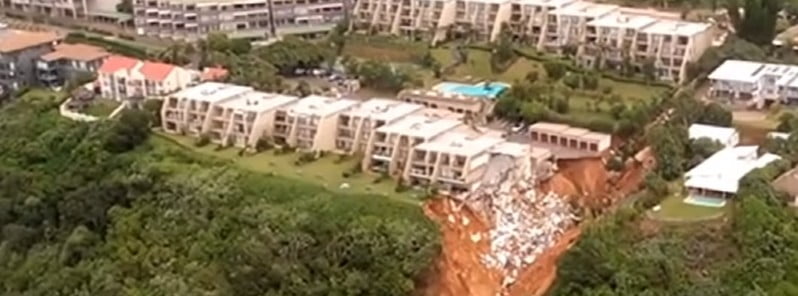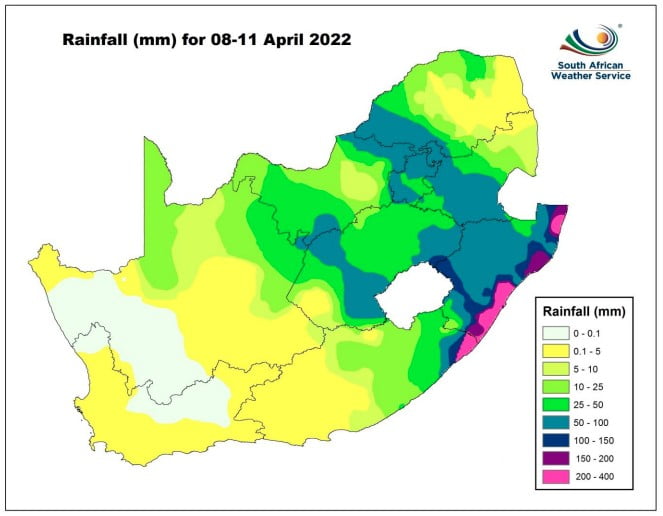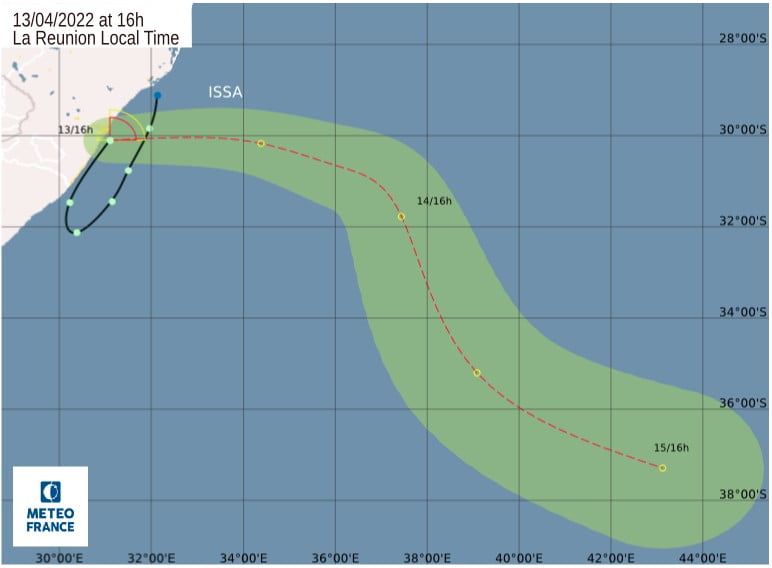More than 440 people killed after catastrophic floods and landslides hit Durban, KwaZulu-Natal, South Africa

At least 443 people have been killed in severe floods and landslides affecting South Africa’s KwaZulu-Natal province, particularly the city of Durban, since April 10, 2022. There are still dozens of people missing and the death toll is expected to continue rising.
- The city of Durban suffered the heaviest rains in more than 60 years, resulting in catastrophic floods and landslides.
- South Africa’s president Cyril Ramaphosa described the event as ‘a catastrophe of enormous proportions.’
- The entire province of KwaZulu-Natal has been declared a disaster area.
- Some officials are labeling the floods as the worst in the country’s history.
The rains were brought by Subtropical Depression “Issa” – officially named by RSMC La Reunion at 12:00 UTC on April 12.
“Following a weekend of widespread rainfall over much of the country this past weekend, the cut-off low system responsible for the inclement weather began moving eastwards over KwaZulu-Natal and the Eastern Cape overnight,” the South African Weather Service said April 12, adding that whilst impact-based warnings were indeed issued in a timely manner, it appears that the exceptionally heavy rainfall overnight and this morning exceeded even the expectations of the southern African meteorological community at large.1
At 16:00 LT on April 11, a Level 5 warning was issued for the coast and adjacent interior of KwaZulu-Natal. This was subsequently escalated to a Level 8 warning at 20:00 LT. However, following reports of further impacts and persistent, heavy rainfall, SAWS has upgraded the heavy rain warning to an Orange Level 9 for the remainder of April 12.
“Overnight rainfall reports from KwaZulu-Natal have underscored the particularly heavy and extreme nature of the rainfall, with some 24-hour falls exceeding 200 mm (7.8 inches),” SAWC said.
More noteworthy, is that a few stations even reported 300 mm (11.8 inches) or more.
A selection of the highest overnight rainfall measured in KwaZulu-Natal includes King Shaka International Airport (225 mm / 8.85 inches), Margate (311 mm / 12.2 inches), Mount Edgecombe (307 mm / 12 inches), Port Edward (188 mm / 7.4 inches) as well as Virginia airport (Durban north) with 304 mm / 11.9 inches.
“Such rainfall is of the order of values normally associated with tropical cyclones; however, SAWS must strongly emphasize that this system is not tropical in nature, nor is it a tropical cyclone.”
Another 100 mm (4 inches) fell along the southeastern coast of South Africa in 6 hours to 12:00 UTC on April 13, as reported by RSMC La Reunion. However, the rains continued falling over the region through the rest of the day as Issa slowly drifted away from the coastline.
“As Issa weakens and moves away from the coast, the rainfall character will decrease and will be more confined to the sea off the coast,” RSMC La Reunion said in their last bulletin for the system, issued at 12:00 UTC on April 13.2
“The improvement of the weather conditions should logically be more marked at the end of the day.”
What was the reason for the heavy rain?
“In short, as alluded to earlier, a cut-off low in the upper reaches of the troposphere is currently moving seawards, off the eastern coast of South Africa. Cut-off lows are associated with widespread instability in the atmosphere, which can promote periods of prolonged rainfall, as witnessed over many of the interior provinces of South Africa at the weekend. For KwaZulu-Natal however, the effect of the cut-off low system has been markedly enhanced by the presence of sustained low-level maritime air which has been fed in from the southern Indian ocean, thus driving the system to produce more rainfall,” SAWC said in the release.
“Moreover, the original source of the maritime air was from warmer, sub-tropical parts of the ocean, with a greater capacity to transport moisture, an essential ingredient of any rain-producing system.”




“It’s an absolute nightmare, lots of mudslides, casualties, collapsed buildings,” Garrith Jamieson, a rescue worker, told AFP on April 12.
Some in the city of Durban were seen standing on rooftops awaiting rescue on April 12, but local media report that only one helicopter was available to lift people away.
Key roads across the city were shut and mudslides have destroyed many homes.
After visiting survivors in one of the townships in the city of Durban, South Africa’s President Cyril Ramaphosa described the event as “a catastrophe of enormous proportions”.
“The bridges have collapsed, the roads have collapsed, people have died and people are injured.”
“This disaster is part of climate change. It is telling us that climate change is serious, it is here,” Ramaphosa said. “You’re not alone … We’ll do everything in our power to see how we can help. Even though your hearts are in pain, we’re here for you,” he added.3
While the military was called in to help rescue affected residents, their efforts were delayed until Wednesday, April 13 as the ‘military’s air wing was also affected by the floods,’ General Rudzani Maphwanya said.
Most of the province suffered water shortages as well as power cuts after heavy flooding at various power stations.
Scores of hospitals and more than 500 schools have been destroyed in what’s being described as one of South Africa’s worst natural disasters.
The weather improved significantly on April 14.
The latest reports coming from the region are mentioning looting in Boxer and Usave stories in Umlazi, near Durban.
The Department of Co-operative Governance in KwaZulu-Natal has appealed to people, whose homes were damaged and washed away by floodwaters, to refrain from immediately returning to disaster-stricken areas.
References
1 Extreme rainfall and widespread flooding overnight: KwaZulu-Natal and parts of Eastern Cape – Media Release by SAWC on April 12, 2022
2 RSMC / TROPICAL CYCLONE CENTER / LA REUNION TROPICAL CYCLONE FORECAST WARNING NUMBER: 5/11/20212022 – SUBTROPICAL DEPRESSION 11 (ISSA)
3 At least 306 killed in catastrophic flooding in Durban, South Africa’s President calls it a climate change disaster – ABC – April 14, 2022
Featured image credit: SABC (stillshot)






“This disaster is part of climate change. It is telling us that climate change is serious, it is here,” Ramaphosa said.”
PURE IGNORANCE!!! It is NOT ‘climate change’. What is happening now is EARTH CHANGES!!! And these EARTH CHANGES are part of Earth’s NORMAL CYCLE. We are now in one of our (12,000 YEAR) NATURAL, NORMAL CYCLES, which includes the SHIFTING POLES!!
People had better STOP with the ‘climate change’ NONSENSE PROPAGANDA LIE, and start paying attention to the MASSIVE EARTH CHANGES, that is part of Earth’s NORMAL, NATURAL CYCLE. What IS coming is an ‘EXTINCTION EVENT’…..and if one wants to REMAIN IGNORANT, and follow the Evil Globalists’ ‘climate change’ LIE, then you will NOT SURVIVE WHAT IS COMING!
To LEARN more (aka REALITY), go to the YT channel, Suspicious0bservers (Ben Davidson author of ‘The Next End of the World: The Rebirth of Catastrophism’).
What is coming with these MASSIVE EARTH CHANGES has happened MANY TIMES BEFORE. It has happened LONG BEFORE Humans were here, and will CONTINUE to happen, LONG AFTER we are GONE!